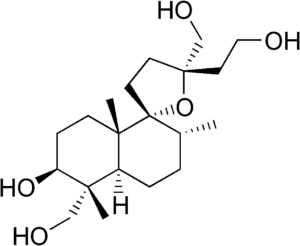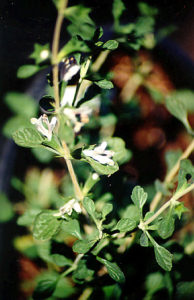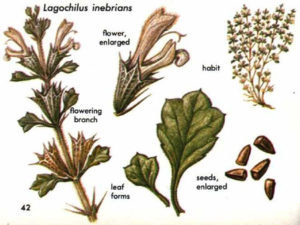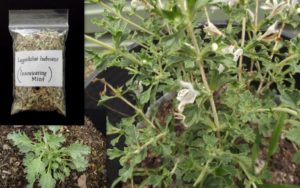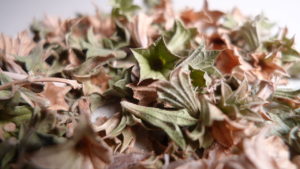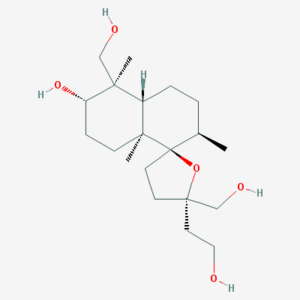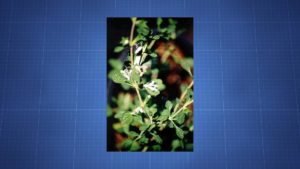 Lagochilus inebrians is a shrub which has historically been made into a tea. It is said to offer some mild psychoactive effects and people have attached medical uses to the plant.
Lagochilus inebrians is a shrub which has historically been made into a tea. It is said to offer some mild psychoactive effects and people have attached medical uses to the plant.
The shrub is a member of the mint (lamiaceae) family. It might provide mild euphoria and sedation.
Because of its significant bitterness, sweetening agents are often added to the tea.
Lagochilus inebrians = Intoxicating Mint; Turkistan Mint; Inebriating Mint; intoxicating hare’s lip; Turkestan Mint
Lagochilin = Lagochiline; AC1OEQ0K
PubChem: 7061097
Molecular formula: C20H36O5
Molecular weight: 356.503 g/mol
IUPAC: (1R,2S,4aS,5R,5’S,6R,8aS)-5′-(2-hydroxyethyl)-1,5′-bis(hydroxymethyl)-1,4a,6-trimethylspiro[3,4,6,7,8,8a-hexahydro-2H-naphthalene-5,2′-oxolane]-2-ol
Contents
Dose
Oral (tentative)
Range: 3 – 10 grams
Oral (extract; tentative)
Total range: 2 – 30 mg
Most common range: 2 – 10 mg
Inhalation (extract; tentative)
Range: 20 – 40 mg
Timeline
Oral (tentative)
Total: 3 – 5 hours
Onset: 00:10 – 00:30
Experience Reports
Effects
Positive
- Euphoria
- Sedation
- Relaxation
Negative
- Drowsiness
- Nausea
- Vomiting
- Unsteady gait
- Cognitive impairment
The plant, usually taken as a tea, is reported to offer calming and sedating effects. It doesn’t sedate the user to the point of sleep at common doses and may preserve or enhance some mental activity (e.g. interest or creativity.)
It’s a mild substance overall, with little support for some of the alleged hallucinogenic properties. At most, the drug seems to offer minor CEVs.
A body high is commonly reported and described as feelings of tingling and warmth.
Experience Report Excerpts
Experience 1
- Inhalation
- “Felt a nice relaxing buzz”
- Described the drug as mild with a minor tingling body high.
Experience 2
- Oral
- “Left me very relaxed but alert, with no bad after effects.”
- It produced no activity on another occassion.
Experience 3
- Lagochilin itself was used
- 20 mg inhaled
- Mild stimulation and “clarity of mind.”
- Followed by 3x 20 mg intranasal administrations
- “I find myself feeling pretty good, comfortable, and mildly stimulated.”
- “I started nodding off at the computer.”
- “I sat and nodded and scanned the internet in a very relaxed and interested state until sleep got the better of me, and I woke up at 3:30 am and went to bed.”
Experience 4
- Oral (4 grams)
- “Noticeable effects, relaxed body with exhilaration of the mind.”
- “Very euphoric with definite body stone.”
- “Music delightful, television engaging whether documentary on fossils or The Tomorrow People.”
Experience 5
- Oral
- “I felt a mild relaxation and intoxication.”
- “And it was more sedating and less cloudy than I find beer.”
Experience 6
- “Balance is a little impaired. Everything is cool and not threatening. But all this seems very ‘normal’ , without a great euphoria.”
- “It was a pleasant experience. A very relaxing tea for a calm afternoon. It mixed well with pot, but my advice is to be careful and to smoke very little.”
Chemistry & Pharmacology
Chemistry & Sourcing
L. inebrians is primarily found in Uzbekistan, Turkmenistan, and Tajikistan.
Lagochilin, a diterpene present in the plant, has received the most attention. It may be found at an average concentration of 3% in dried plant material. The chemical’s full connection to the plant’s effects isn’t clear.
Other similar chemicals also found in L. inebrians include lagochilin-3-acetate and lagochilin-tetraacetate, which could be contributing to the activity.
Stachydrine, an alkaloid, is present.
Pharmacology
Mostly unavailable due to a lack of information, but there has been some research into stachydrine.
Stachydrine
The alkaloid has been found to protect human umbilical vein endotheial cells (HUVECs) in a model of damage triggered by anoxia-reoxygenation (A/R). A/R normally precipitates greater tissue factor (TF) expression and is associated with reactive oxygen species (ROS) production and inflammation.
Stachydrine dose-dependently inhibited TF expression and reduced ROS production and inflammation. It improved cell survival overall.
History
Unknown start date
L. inebrians has been used as a tea in Turkestan for an indeterminate period of time. Turkestan is a Central Asian region including parts of Russia, Uzbekistan, Tajikistan, Mongolia, Turkmenistan, Kazakhstan, and Afghanistan.
At least for centuries
It’s been taken in Turkestan by the Tajik, Tatar, Turkmen, and Uzbek ethnic groups.
- Tajik: Tajikistan, Afghanistan
- Tatar: Mongolia
- Turkmen: Turkmenistan
- Uzbek: Uzbekistan
The process for use generally involves gathering the leaves in October, which is followed by drying. The stems, fruits, and flowers may also be used.
A tea is made, with sugar/honey being added to reduce the bitterness.
1945
Lagochilin is isolated from L. inebrians. It’s initially referred to as “lagochiline.”
While it was thought to be an alkaloid, that has turned out to be inaccurate.
1946
The 8th Edition of the State Pharmacopoeia of the Russian Federation is released and includes the plant.
It’s listed as a traditional medicine that is taken for allergies, to accelerate blood clotting, to reduce hypertension, and to treat skin diseases. When taken as a tea, the perceptible changes include mild euphoria and sedation.
L. inebrians could also be steeped in alcohol to create a tincture.
1950s
Investigations took place in Russia, leading to the discovery of lagochilin’s molecular formula.
1960s
More research based in Moscow, Russia allowed a structure to be attached to lagochilin. It was then listed as a tricyclic diterpene.
1971
Robert Gordon Wasson briefly discussed it while writing about Soma, a drug mentioned in the Rigveda. In his words:
[I] harbored the secret notion that Soma would turn out to be a member of the mint family, Lagochilus inebrians.
He said it was “used as an hallucinogen as far back as we can trace its history.” Prior to his interest in the plant, it “had never been suggested as Soma.”
Wasson eventually switched to his more widely explorered hypothesis that Soma was actually a mushroom, namely Amanita muscaria.
1990s – Present
There have been a handful of reports about its effects and some online vendors are selling it.
Its overall use (at least outside of its traditional location) is low.
Legal Status
USA
Federally
The plant and lagochilin aren’t controlled. (November 2016)
States
Louisiana lists L. inebrians as a controlled substance, but only when intended for human use.
Controlled
No countries appear to list either the plant or lagochilin as illicit substances. But, you should always check your local laws.
Safety
Due to a lack of information, it’s not clear how safe the drug is, particularly with repeated use.
It’s best to use common doses, avoid combinations, and minimize your use frequency.
References
(2002) Structure-Activity Relationship for Hemostatic Lagochilin Diterpenoids
(1971) The Soma of the Rig Veda: What Was It?
(1970) The Botanical and Chemical Distribution of Hallucinogens
(1969) Structure of lagochilin










